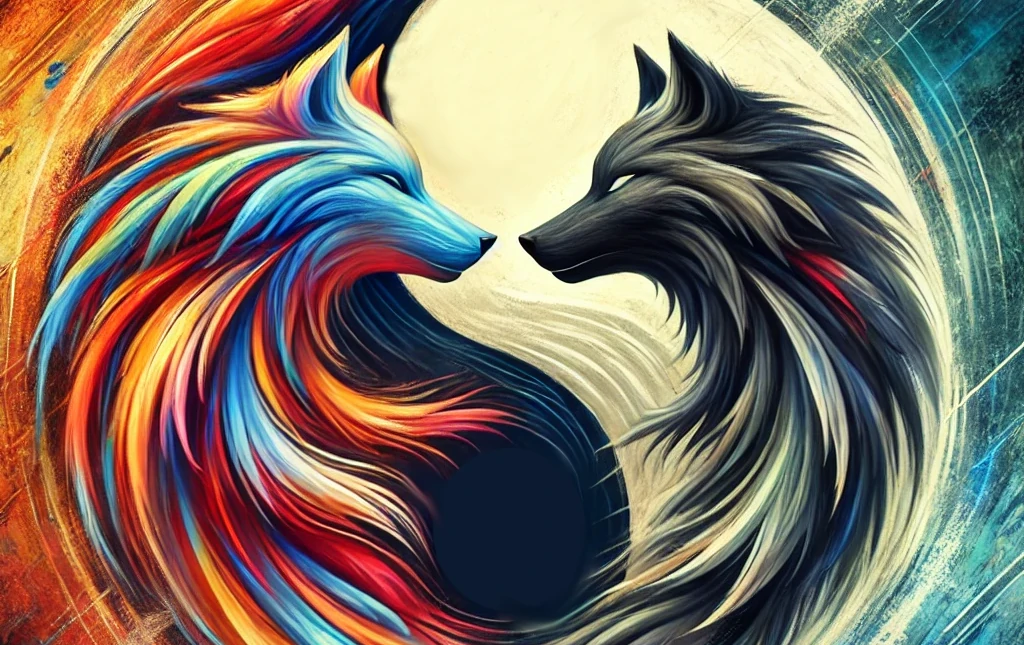
You’ve probably heard the parable of the two wolves—one representing our darker instincts, the other our better nature. The idea is that the wolf you feed is the one that thrives. But in the context of innovation, I’ve come to believe the real challenge isn’t choosing which wolf to feed, but learning how to nurture both.
One wolf represents divergent thinking—the mind that runs wild with unrestrained, endless possibilities. The other is convergent thinking—the disciplined, focused mind that brings clarity and execution to those ideas. I navigate this tension daily, both in my work as a strategist and in my personal artistic journey.
Many years after attending art school, I decided to pursue master draftsmanship through the traditional atelier model, specifically using the Grand Central Atelier (GCA) methods. For those unfamiliar, this fine art method emphasizes precision, observation from life, and classical technique—a practice that might seem far removed from digital strategy, but in truth, there are clear parallels.
Much like the early stages of an innovation project, my artwork begins with a period of divergent thinking. I allow myself to explore the subject freely, not knowing exactly where it will lead. This was evident in my project American Music (inspired by the Violent Femmes song of the same name). The concept for the painting revealed itself to me slowly, much like finding a melody within the noise. At this stage, the possibilities are limitless.
Then comes a necessary shift—the Convergent Wolf steps in. Once I’ve found my direction, I move into a precise, focused mode, where hours of labor go into perfecting the details. In art, this means refining tones, adjusting shadows, and capturing the nuances that bring a piece to life. In my professional work, this shift happens when concepts move from imagination to execution—when user research, data analysis, and strategic planning turn abstract notions into real-world outcomes.
This is an inherent struggle for most of us. We either live unrestrained in the divergent mode, endlessly exploring ideas without bringing them to fruition, or we cling to the predictability of convergent thinking, trying to control ideas before they’ve had a chance to evolve. But through both my professional and artistic practices, I’ve learned that true innovation only happens when you encourage both wolves.
In every project I lead, whether crafting a product roadmap or refining a strategic vision, the tension between creativity and pragmatism is always present. I work with teams to embrace this dynamic—encouraging unbounded ideas from the wild Divergent Wolf, which may seem unfocused at first but reveal valuable insights into where things could go. Then, we shift to the wise Convergent Wolf, refining those ideas together into something actionable and concrete. When we get it right, the two modes feed off each other, creating something greater than either could alone.
Balancing divergent and convergent thinking isn’t just a business strategy—it’s essential for achieving meaningful outcomes in any field. Without divergence, you miss the creative breakthroughs that lead to innovation, and without convergence, those ideas will never see the light of day. This is also why companies can’t ‘research’ their way into innovative products—while research helps to ground ideas in reality, it’s the creative leaps and visionary thinking beyond the data that produce the most valuable results. Successful products emerge when companies balance research with creativity, execution, and the willingness to explore what’s possible beyond what’s known.
“This is also why companies can’t ‘research’ their way into innovative products“
Research is invaluable for understanding user needs and market trends, but it’s inherently backward-looking. Groundbreaking innovation comes from generating new possibilities through divergent thinking—creative leaps that can’t always be predicted by data. Progress requires a balance between research, creativity, and disciplined execution, fueled by human intuition and vision to push boundaries and create transformative products.
This same balance applies to mastering any craft, whether in business or art. Masters don’t simply copy what they see; they interpret, with deep understanding and intention. The journey begins with the spark of an idea and the freedom to explore, but it soon transitions into discipline and focus. Each brushstroke, each adjustment to tone, represents hours of dedicated work, yet all of it stems from the initial creative freedom. Sometimes, honing in on the details sparks unexpected discoveries—where the Divergent and Convergent Wolves meet once again, harmoniously collaborating in new and unexpected ways.
So, which wolf do I feed? Both. Because in the end, it’s not about choosing between creativity and execution—it’s about the dance between them. And that’s where real innovation—and mastery—happens.
Like to learn more about divergent and convergent thinking in technology innovation? Check out the following materials:
The Synergy of Diverge and Converge in Design Thinking – Voltage Control: How divergent and convergent thinking are essential in the design thinking process, offering practical tips on how to integrate these approaches into innovative projects.
Unleash the Unexpected for Radical Innovation – MIT Sloan Management Review: Explores how radical innovation often emerges from unexpected ideas, highlighting the importance of environments that encourage divergent thinking and creativity. (May require subscription)
The Design of Everyday Things – Don Norman: A classic UX book, essential for understanding design thinking, usability, and balancing creativity with practical application in product design.
About the Author
Dorothy is a digital strategist and researcher who helps companies turn big ideas into real-world innovations. Outside of work, she is applying this same balance of creativity and focus to her current pursuit of master draftsmanship.


